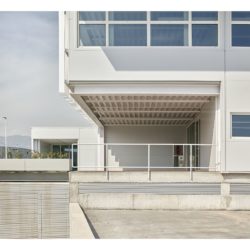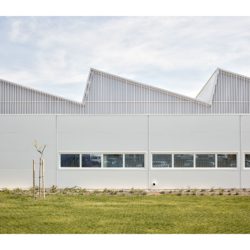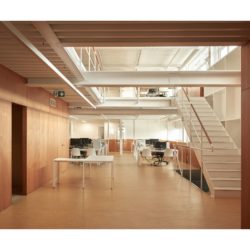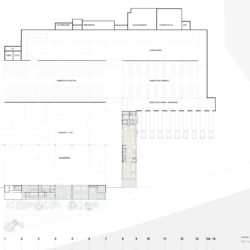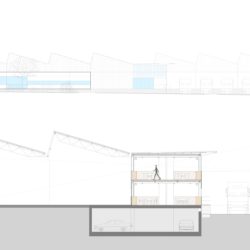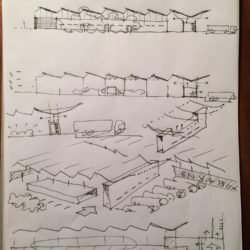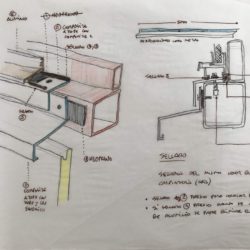
Estudio Alberto Burgos . Javier Cortina . Teresa Carrau . photos: © Mariela Apollonio
In the age of the image, of the dizzying generation, editing, transmission, communication and dissemination of images, it might be convenient to remember with The Little Prince that many important things, perhaps the most important, are not seen:
“- The essential is invisible to the eyes.”
ARCHITECTURE THAT IS NOT SEEN
“Form is not the aim of our work, but only the result. Form as an aim inevitably results in mere formalism.”
Mies van der Rohe, 1923
There is a fundamental basis in the efficiency of a factory of this type: having a large work surface. A large FLAT, clear and orderly plane is the foundation of the efficiency of the process: it facilitates communication between different high-speed machines fed by what was produced by any of the above. It was the first achievement of the project. It doesn’t show, but it wasn’t like that before. (Like all those cables that crossed the property: you don’t see them, but it wasn’t like that before.)

A “Cardboard Box Factory” IS a huge, lightning-fast printer. Huge, in scale and numbers. It feeds on paper reels, like our plotters, but about 2.5m high x 2.5 meters in diameter, of about 2.5 tons each. In the corrugator it takes thickness. It generates about 250,000 M2 / day of different corrugated cardboard. And if the previous machines transformed them at about 40,000 boxes/ day, the new one can reach 20,000 boxes/hour.
Our main performance came down to ORDERING where things, people and flows should be — maintaining and prolonging the wonderful original 25x10M GRID. You can’t see that either, but the rigidity of the checkerboard is what allows for flexibility in the game. Maintaining the chessboard has allowed the pieces to move freely during various project versions. And will enable continue doing so in the future.
The project studied the expansion of a factory in full production. The work too. “Between production and construction, premium production.” That was a motto of the property that clarified the solution to the potential conflicts. In fact, all of our project and construction work could look like this: a simple wrap on the new large box making machine delicately leveled on the new flat plane. And, as in Saint-Exupéry’s drawings, where some see a hat, others an elephant.
_
Fábrica de Cartones. Ampliación
Crevillente (Alicante) 2.500 + 1.800 m2
promotor: TEMOCA.
arquitectura: ESTUDIO ALBERTO BURGOS, Javier Cortina, Teresa Carrau. ingeniería: Joaquin Solbes, Jose Luis Perez.
imagen: Gabriel Fabra
constructora: Los Serranos. Eiffage Infraestructuras. estructuras: Martinez-Terres. Javier del Rio. carpintería: Technal.
puertas metálicas: Novoferm Alsal
proyectos 2016- 2018
obra 2019 -2020
fin de obra (fase1) 20200731
ARQUITECTURA QUE NO SE VE “La Forma no es el fin de nuestro trabajo, solo el resultado. La Forma como fin, acaba en mero formalismo.” Mies van der Rohe, 1923 En la era de la imagen, de la vertiginosa generación, edición, transmisión, comunicación y difusión de imágenes podría ser conveniente recordar con El Principito que muchas cosas importantes, quizá las más importantes, no se ven: “- Lo esencial es invisible para los ojos." Hay una base incontestable en la eficiencia de una fábrica de este tipo: disponer de un gran plano de trabajo. Un gran plano PLANO, despejado y ordenado es el fundamento de la eficacia del proceso: facilita la comunicación entre distintas máquinas rapidísimas que se alimentan de lo que produjo alguna de las anteriores. Fué el primer logro del proyecto. No se nota, pero antes no era así. (Como todos aquellos cables que cruzaban la propiedad: no los ves, pero antes tampoco era así.) Una "Cardboard Box Factory" ES una enorme y velocísima impresora. Enorme, en escala y en cifras. Se alimenta de bobinas de papel, como nuestros plotters, pero de unos 2,5m de alto x 2,5 metros de diámetro; de unas 2,5 toneladas cada una. En la onduladora toma espesor, generando unos 250.000 M2 / dia de distintos cartones ondulados. Y si las máquinas previas los transformaban en unas 40.000 cajas / día, la nueva puede alcanzar las 20.000 cajas / hora. Nuestra principal actuación se redujo a ORDENAR dónde deben estar las cosas, las personas y los flujos. Manteniendo y prolongando la estupenda RETICULA original de 25x10M. Eso tampoco se ve, pero la rigidez del damero es lo que permite la flexibilidad del juego. Mantener el tablero de juego es lo que ha permitido mover con libertad las piezas durante diversas versiones del proyecto. Y lo que permitirá seguir haciéndolo en el futuro. El proyecto estudió la ampliación de una fábrica en plena producción. La obra también. “Entre producción y construcción, prima producción”. Ese fue un lema de la propiedad que esclareció la solución ante los imaginables conflictos. De hecho, todo nuestro trabajo de proyecto y obra podría verse como una simple envoltura sobre la nueva gran máquina productora de cajas, delicadamente nivelada en el nuevo plano plano. Y, como en los dibujos de Saint-Exupéry, donde unos ven un sombrero, otros, un elefante.




